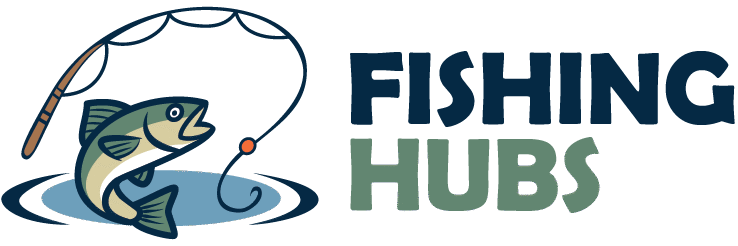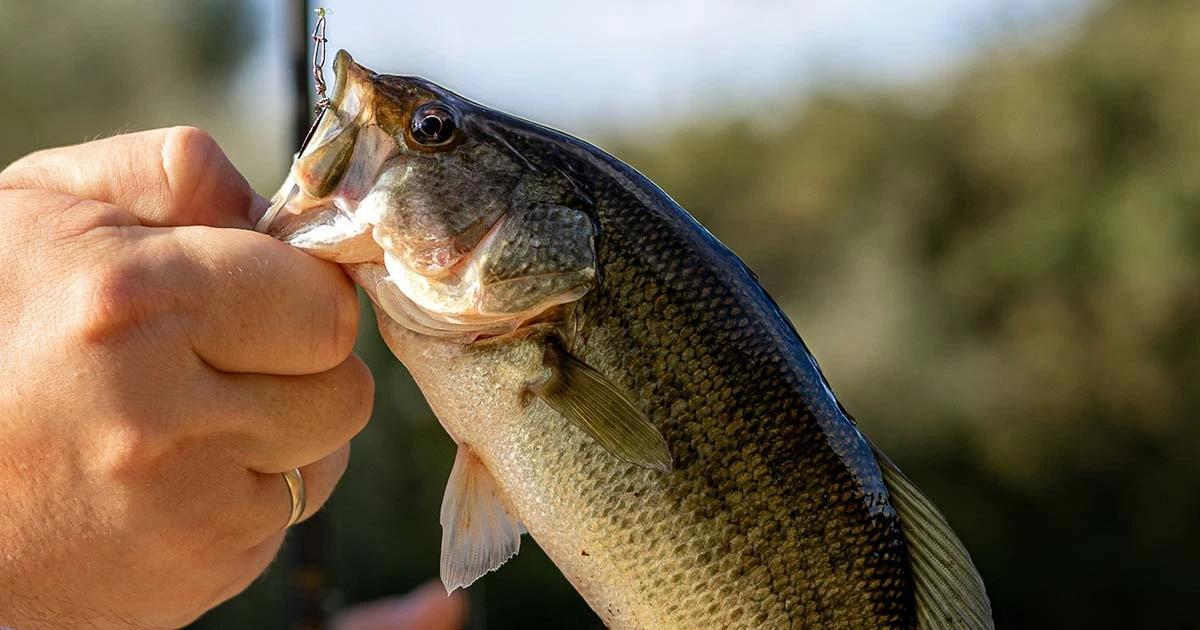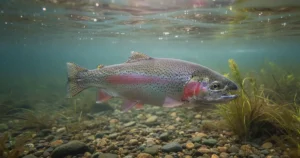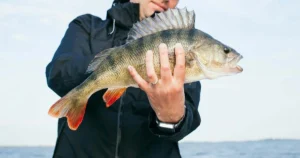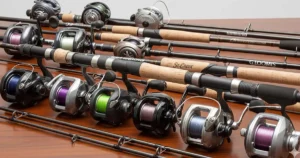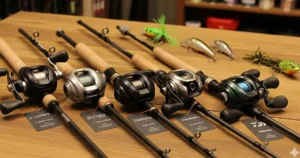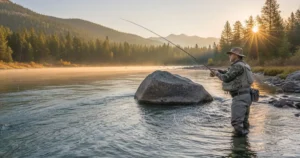How Big Can Striped Bass Get? Discover Record Catches
Table of Contents
Have you ever wondered just how massive a striped bass can grow? For anglers across the United States, the pursuit of the biggest striped bass is a lifelong passion, filled with anticipation, skill, and sometimes, a little bit of luck. This guide will take you through the impressive dimensions these fish can reach, highlight some legendary catches, and provide you with essential tips on how you can potentially land your own trophy striper.
From their powerful runs to their striking silver and dark-striped appearance, striped bass, often affectionately called “stripers” or “rockfish,” are a highly sought-after game fish. They represent a formidable challenge for any angler, and knowing their potential size only adds to their allure. So, let’s dive into the world of these magnificent fish and uncover the secrets to catching them.
What is a Striped Bass? An Introduction to a Premier Game Fish
Before we delve into the records, it’s important to understand the species itself.
Striped bass (Morone saxatilis) are renowned for their strength and size, making them a favorite target for recreational and commercial fishing. But are striped bass freshwater or saltwater fish? The answer is both! Striped bass are anadromous, meaning they spend most of their adult lives in saltwater but migrate to freshwater rivers and estuaries to spawn. This unique characteristic allows them to inhabit a wide range of environments, from coastal oceans to landlocked lakes and rivers, making them accessible to a broad community of anglers.
You’ll find them along the Atlantic coast from Canada to Florida, with significant populations in the Chesapeake Bay, Delaware Bay, and Hudson River, which are vital spawning grounds. On the West Coast, they were introduced to the San Francisco Bay in the late 19th century and have since established populations in various rivers and estuaries.
The Phenomenal Size of Striped Bass
So, how big can striped bass get? These impressive fish are the largest of the temperate basses. On average, adult striped bass typically range from 2 to 3 feet in length and weigh between 10 to 30 pounds. However, don’t let those averages fool you; they can grow significantly larger! Striped bass have been known to reach lengths of six feet and tip the scales at over 125 pounds. The largest specimens are typically mature females, which grow larger than males.
Imagine the thrill of hooking into a fish that could be taller than you and weigh more than a small person! This potential for truly colossal catches is what drives many anglers to dedicate themselves to pursuing the biggest striped bass.
Understanding Striped Bass Growth
Several factors contribute to the impressive size of striped bass:
- Age: Like many fish, striped bass continue to grow throughout their lifespan, which can extend up to 30 years or more. Older fish generally equate to larger fish.
- Food Availability: A rich and consistent food source is crucial for growth. Areas with abundant baitfish and invertebrates will support larger, healthier stripers.
- Genetics: Some individual fish simply have the genetic predisposition to grow larger than others.
- Habitat: Access to diverse habitats, including both freshwater spawning grounds and nutrient-rich ocean environments, allows stripers to thrive and reach their maximum potential.
Discovering Record Catches: The Giants of the Striper World
For many anglers, the dream is to land a fish that puts them in the record books. The biggest striped bass ever caught is a testament to the incredible potential of this species.
The current all-tackle world record for a striped bass, as recognized by the International Game Fish Association (IGFA), belongs to Gregory Myerson. On August 4, 2011, Myerson caught an astounding 81-pound, 14-ounce striped bass while drifting a live eel in Long Island Sound, off Westbrook, Connecticut. This monumental catch measured 54 inches in length – nearly four and a half feet long!
Before Myerson’s incredible feat, Albert McReynolds held the all-tackle record for decades with a 78-pound, 8-ounce striper caught from a jetty in Atlantic City, New Jersey, in 1982. This just goes to show that you don’t always need a boat to land a monster.
It’s also important to note the distinction between saltwater and landlocked striped bass records. While the saltwater records are truly colossal, landlocked striped bass can also reach impressive sizes. The all-tackle record for a landlocked striped bass is held by James Bramlett, who caught a 69-pound, 9-ounce striper in the Black Warrior River, Alabama, in 2013, using live gizzard shad. These landlocked giants demonstrate that even in freshwater environments, the biggest striped bass can still be found.
Here are some other notable record catches that highlight the immense size these fish can attain:
- Robert Rocchetta’s 76-pound striper: Caught near Montauk Point, New York, in 1981, this fish was a testament to the rich waters of Long Island.
- John Baldino’s 71-pound striper: Landed off Norwalk, Connecticut, in 1980 using live bunker, showcasing the effectiveness of natural bait.
- Mark Alexander Foster’s 124-cm (approx. 49-inch) release: In 2020, Foster measured and released a colossal striper in the Chesapeake Bay, demonstrating that length-based records allow for the conservation of these magnificent fish.
These records serve as an inspiration and a reminder that the ocean, and even some freshwater systems, hold truly magnificent specimens.
How to Catch Striped Bass: Your Guide to Landing a Trophy
Now that you’re inspired by the potential size of these fish, let’s talk about how you can increase your chances of catching them. Landing a biggest striped bass requires a combination of knowledge, the right gear, and strategic fishing techniques.
Understanding Striped Bass Behavior
To effectively catch stripers, you need to think like a striper. They are opportunistic predators with a keen sense of their surroundings.
- Migration: Striped bass undertake significant migrations along the coast, moving north in the spring and south in the fall in search of comfortable water temperatures and abundant food. Understanding these patterns is key to finding them.
- Feeding Habits: Stripers feed on a wide variety of prey, from small invertebrates to larger baitfish. Their diet can change seasonally and regionally, so being adaptable is crucial.
- Preferred Habitat: While they are migratory, stripers often congregate around structures that offer ambush points or strong currents that bring food. This includes inlets, bridges, rocky shorelines, and areas with submerged structures.
Choosing the Right Gear
Your equipment needs to be up to the task of handling a powerful fish like a striped bass.
- Rods and Reels: For targeting larger stripers, you’ll want a medium-heavy to heavy action rod, typically 7 to 10 feet long, paired with a robust spinning or conventional reel capable of holding at least 200-300 yards of 30-50 pound braided line. The extra length on the rod helps with casting distance and fighting a big fish.
- Line: Braided line is highly recommended due to its strength, thin diameter, and lack of stretch, which provides excellent sensitivity. A fluorocarbon leader (30-80 lb test, depending on the conditions) is often used for its abrasion resistance and low visibility in water.
- Terminal Tackle:
- Hooks: Use strong, sharp hooks. For live bait, circle hooks are often preferred as they reduce gut-hooking, promoting healthy release, especially for larger, older fish. Make sure the hook size is appropriate for your bait and target fish to avoid catching too many undersized stripers.
- Weights: Depending on the current and depth, you’ll need a selection of sinkers (pyramid, egg, or coin weights) to get your bait to the strike zone.
- Swivels: High-quality barrel swivels help prevent line twist.
The Best Bait for Striped Bass
Choosing the right striped bass bait is critical. Stripers are not overly picky, but certain baits consistently outperform others.
- Live Bait: This is often considered the best bait for striped bass, especially when targeting large specimens.
- Eels: A long-standing favorite, particularly for catching trophy stripers at night. Live eels are incredibly effective.
- Bunker (Menhaden): Both live and cut bunker are excellent. Bunker are oily and have a strong scent trail that attracts stripers from a distance. Many of the record catches were made using live bunker or eels.
- Herring and Shad: These are natural prey for stripers, especially during their spawning runs.
- Mackerel: A top choice in areas where mackerel are abundant.
- Cut Bait: If live bait isn’t feasible, fresh cut bait can be highly effective. The scent trail it creates is a major attractant.
- Cut Bunker/Menhaden: Popular and readily available.
- Squid: A versatile bait that appeals to many predatory fish, including stripers.
- Artificial Lures: When stripers are actively feeding on schools of baitfish, artificial lures can be incredibly productive.
- Plugs (e.g., lipped swimmers, poppers): Excellent for imitating baitfish on the surface or just below. Poppers are thrilling when stripers are crashing bait on top.
- Soft Plastics (e.g., swim shads, plastic eels): Versatile and can be rigged in various ways to mimic different prey.
- Bucktails: A classic and highly effective lure, especially when tipped with a piece of Gulp! or a soft plastic trailer.
- Metal Jigs: Good for targeting fish in deeper water or when they are feeding on sand eels or other slender baitfish.
What to Use to Catch Stripers: Techniques for Success
Knowing what to use to catch stripers extends beyond just bait and lures. It’s about how you present them.
- Live Lining: This is a highly effective method, especially for big fish. You hook a live baitfish (like a bunker or eel) and let it swim naturally, either free-lining it or using a small weight to get it to the desired depth. This technique perfectly mimics the stripers’ natural prey.
- Trolling: Covering large areas by pulling lures or rigged baits behind a boat is a great way to locate schools of feeding stripers. Umbrella rigs, mojos, and large swimming plugs are often used for trolling.
- Casting and Retrieving: Whether from shore, a jetty, or a boat, casting artificial lures or bait into promising areas is a fundamental technique. Vary your retrieve speed and action to find what the fish are responding to. Look for signs of baitfish, diving birds, or splashes that indicate active feeding.
- Chunking: This method involves cutting up baitfish (like bunker) into chunks and throwing them into the water to create a scent trail, then fishing a hooked chunk in the chum line. This can draw in stripers from a distance.
- Surf Fishing: For the shore-bound angler, surf fishing can be incredibly rewarding. Look for rips, channels, and structure where stripers might ambush prey. Using bait like cut bunker or clam, or casting large plugs, can yield excellent results.
- Night Fishing: Many of the biggest striped bass are caught at night. Stripers often move into shallower water to feed under the cover of darkness, and large eels are particularly effective during these hours.
Key Considerations for Striper Fishing
- Tides: Tides play a crucial role in striper fishing. Moving water, especially the incoming or outgoing tide, creates currents that disorient baitfish and concentrate food, making stripers more active.
- Time of Day: While night fishing is popular for big stripers, dawn and dusk also offer excellent opportunities as light conditions are low, and stripers feel more comfortable hunting.
- Water Temperature: Striped bass prefer cooler water temperatures, generally between 55 and 65 degrees Fahrenheit. During warmer months, they may seek deeper, cooler water or become more active during low-light hours.
- Conservation: Striped bass populations are managed carefully, and regulations vary by state. Always be aware of and adhere to local catch limits, size restrictions, and season dates. Consider practicing catch and release, especially for larger, older breeding females, to help ensure the future of the fishery. “Catch and release” photography with careful handling is highly encouraged.
Frequently Asked Questions (FAQ)
Here are some common questions you might have about catching the biggest striped bass:
Q1: Are striped bass good to eat?
A1: Yes, striped bass are highly regarded as a food fish. Their flesh is firm, white, and flaky with a mild, sweet flavor. However, due to concerns about PCB contamination in some areas, especially larger, older fish, it’s wise to check local consumption advisories. Many anglers choose to release the largest fish to help with spawning.
Q2: What is the average size of a striped bass?
A2: On average, adult striped bass typically measure 2 to 3 feet in length and weigh between 10 to 30 pounds. However, as discussed, they have the potential to grow much, much larger!
Q3: How can I find out about local striped bass regulations?
A3: You should always consult your state’s fish and wildlife agency website or obtain a copy of their current fishing regulations. These regulations frequently change to manage fish populations, so staying informed is crucial.
Q4: Is it true that big striped bass are often caught at night?
A4: Absolutely. Many experienced anglers target the biggest striped bass after dark. Stripers tend to be more active and less wary at night, especially in shallower waters, making it an excellent time to target trophy fish.
Q5: What’s the best way to release a large striped bass to ensure its survival?
A5: When releasing a large striped bass, minimize its time out of the water. Use a wet, gloved hand to support its belly, avoid touching its gills, and if possible, use a de-hooking tool to remove the hook quickly. Gently revive the fish by holding it upright in the water until it swims away under its own power.
Conclusion
The pursuit of the biggest striped bass is a thrilling endeavor that combines skill, patience, and a deep appreciation for these powerful fish. From the record-breaking giants that inspire awe to the challenging fight of a healthy striper, every encounter is a memorable one. By understanding their behavior, selecting the right striped bass bait, and employing effective techniques, you can significantly increase your chances of landing a truly impressive fish.
Remember, fishing is not just about the catch; it’s about the experience, the connection with nature, and the continuous learning process. So gear up, head out to your favorite striper grounds, and may your next cast bring you closer to discovering just how big a striped bass can truly get!
Key Takeaways
- The all-tackle world record for a saltwater striped bass is 81 pounds, 14 ounces, caught by Gregory Myerson in Long Island Sound.
- Landlocked striped bass can also reach impressive sizes, with the record standing at over 69 pounds.
- Striped bass are anadromous, meaning they live in saltwater but spawn in freshwater.
- The best bait for striped bass often includes live eels, bunker (menhaden), or herring.
- Effective techniques include live lining, chunking, trolling, and casting artificial lures.
- Night fishing, strong tides, and specific water temperatures can increase your chances of success.
- Always adhere to local regulations and practice responsible catch and release, especially for larger, breeding fish.
